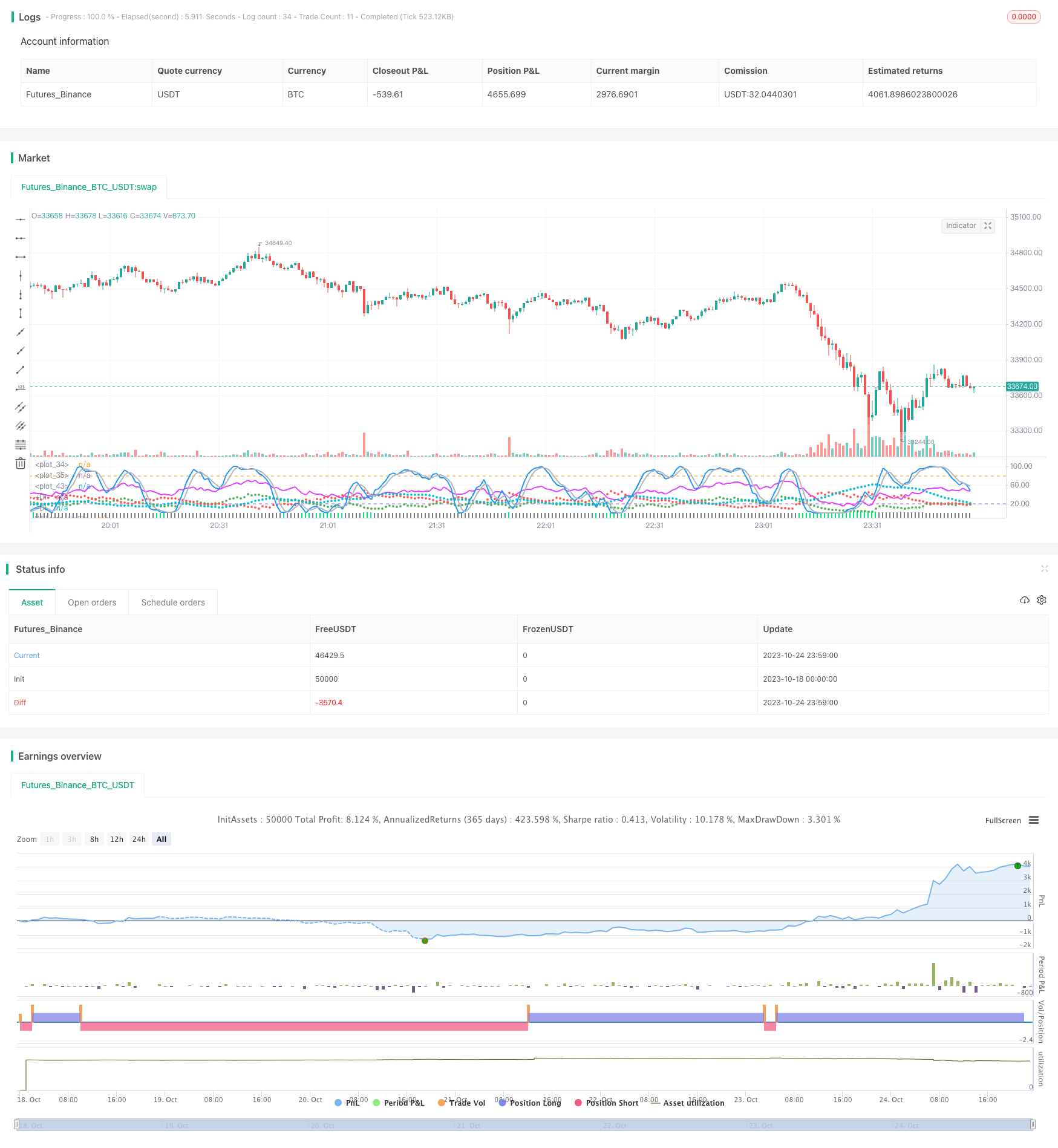
这里是我根据你提供的交易策略代码撰写的详细策略分析文章:
概述
该策略是多个因子组合而成,旨在利用不同因子的优势,构建一个综合性的交易策略。主要组合了以下几个因子:
- Stoch.RSI - 随机指数平滑移动平均线
- RSI - 相对强弱指数
- Double Strategy - 随机指标和RSI的双重策略
- CM Williams Vix Fix - 威廉姆斯波动率修复,寻找市场底部
- DMI - 趋向指标
通过组合多个因子,可以发挥各因子的优势,获取更多交易机会,降低单一因子依赖的风险。
策略原理
该策略主要运用了以下几种技术指标:
Stoch.RSI - 随机RSI指标,结合了RSI和随机指标的优点。它使用RSI值作为随机指标的输入值,来判断市场是否处于超买或超卖状态。当%K线从超买区下穿%D线时,做多;当%K线从超卖区上穿%D线时,做空。
RSI - 相对强弱指数,判断市场的超买超卖状态。RSI大于70时为超买区,小于30时为超卖区。RSI在30-70区间震荡,代表着市场处于横盘整理状态。
Double Strategy - 结合使用随机指标和RSI的双重策略。当随机指标%K线从超卖区下穿%D线,并且RSI从超卖区下穿时,做多;当随机指标%K线从超买区上穿%D线,并且RSI从超买区上穿时,做空。
CM Williams Vix Fix - 威廉姆斯波动率修复指标,通过计算最近一段时间内价格波动率的百分位数范围,判断市场是否处于反转点。超过阈值时为反转信号。
DMI - 趋向指标,通过计算+DI和-DI的差值,来判断市场的趋势方向。ADX指数可用来判断趋势的力度。
综合利用这些指标的各自优势,从不同角度判断市场趋势和买卖点,可以提高策略的稳定性和成功率。
策略优势
- 多因子组合,不同因子取长补短,更加全面;
- 包含趋势、反转等不同类型交易信号,机会更多;
- 同时判断超买超卖区域,及时发现极端状态的形成和反转;
- 采用参数优化的指标设定,更符合不同市场环境;
- 结合趋向指标判断趋势力度,避免逆势交易。
风险分析
- 多因子组合,策略整体鲁棒性有待验证;
- 部分指标存在同质化问题,可进一步优化组合;
- 多空信号同时出现时,需明确策略方向选择原则;
- 参数设置需要严格的回测优化,不适合随意改动参数;
- 长期持有效果可能不佳,需要适时止损退出。
优化方向
- 对组合中的指标进行进一步筛选,保留作用独特的因子;
- 优化每种指标的参数设置,使之更加适合目标市场;
-建立清晰的入场和出场原则;
- 结合止损、获利回撤等方法,以控制风险;
- 测试不同持仓时间对绩效的影响。
总结
该策略综合运用了多种技术指标的优势,通过 Stoch.RSI、RSI、Double Strategy、CM Williams Vix Fix和DMI等因子形成交易信号。它提供了更全面和稳定的判断依据,也使策略参数优化变得更加复杂。通过进一步优化参数设定、筛选独特因子、建立明确的入场出场原则等方法,可以有效提升策略的稳定性和绩效。但整体鲁棒性和长期持有能力还需经过严格验证。该策略为多因子交易策略提供了一个很好的范例,值得学习借鉴。
/*backtest
start: 2023-10-18 00:00:00
end: 2023-10-25 00:00:00
period: 1m
basePeriod: 1m
exchanges: [{"eid":"Futures_Binance","currency":"BTC_USDT"}]
*/
//////////////////////////////////////////////////////////////////////
//// STOCHASTIC_RSI+RSI+DOUBLE_STRATEGY+CM_WILLIAMS_VIX_FIX+DMI ////
//////////////////////////////////////////////////////////////////////
// This is a simple combination of integrated and published scripts, useful
// if you don't have a PRO account and want to bypass the 3 indicator limit.
// It includes:
// 1) Stoch.RSI
// 2) Relative strenght index
// 3) Stochastic + RSI, Double Strategy (by ChartArt)
// 4) CM_Williams_Vix_Fix Finds Market Bottoms (by ChrisMoody)
// 5) Directional Movement Index (DMI)
// For more details about 3) and 4) check the original scripts.
//@version=3
strategy(title="Stoch.RSI+RSI+DoubleStrategy+CMWilliamsVixFix+DMI", shorttitle="Stoch.RSI+RSI+DoubleStrategy+CMWilliamsVixFix+DMI")
///STOCH.RSI///
smoothK = input(3, minval=1, title="Stochastic %K Smoothing")
smoothD = input(3, minval=1, title="Stochastic %K Moving Average")
lengthRSI = input(14, minval=1, title="RSI Lenght")
lengthStoch = input(14, minval=1, title="Stochastic Lenght")
RSIprice = close
rsi1 = rsi(RSIprice, lengthRSI)
k = sma(stoch(rsi1, rsi1, rsi1, lengthStoch), smoothK)
d = sma(k, smoothD)
plot(k, color=blue, linewidth=2)
plot(d, color=silver, linewidth=2)
h0 = hline(80)
h1 = hline(20)
fill(h0, h1, color=purple, transp=78)
///RSI///
up = rma(max(change(RSIprice), 0), lengthRSI)
down = rma(-min(change(RSIprice), 0), lengthRSI)
rsi2 = down == 0 ? 100 : up == 0 ? 0 : 100 - (100 / (1 + up / down))
plot(rsi2, color=fuchsia, linewidth=2)
// band0 = hline(70, linestyle=dotted)
// band1 = hline(30, linestyle=dotted)
// fill(band0, band1, color=purple, transp=100)
///OVERBOUGHT-OVERSOLD STRATEGY///
StochOverBought = input(80, title="Stochastic overbought condition")
StochOverSold = input(20, title="Stochastic oversold condition")
ks = sma(stoch(close, high, low, lengthStoch), smoothK)
ds = sma(k, smoothD)
RSIOverBought = input( 70 , title="RSI overbought condition")
RSIOverSold = input( 30 , title="RSI oversold condition")
vrsi = rsi(RSIprice, lengthRSI)
if (not na(ks) and not na(ds))
if (crossover(ks,ds) and k < StochOverSold)
if (not na(vrsi)) and (crossover(vrsi, RSIOverSold))
strategy.entry("LONG", strategy.long, comment="LONG")
if (crossunder(ks,ds) and ks > StochOverBought)
if (crossunder(vrsi, RSIOverBought))
strategy.entry("SHORT", strategy.short, comment="SHORT")
///CM WILLIAMS VIX FIX///
pd = input(22, title="LookBack Period Standard Deviation High")
bbl = input(20, title="Bollinger Band Length")
mult = input(2.0 , minval=1, maxval=5, title="Bollinger Band Standard Devaition Up")
lb = input(50 , title="Look Back Period Percentile High")
ph = input(.85, title="Highest Percentile - 0.90=90%, 0.95=95%, 0.99=99%")
pl = input(1.01, title="Lowest Percentile - 1.10=90%, 1.05=95%, 1.01=99%")
hp = input(false, title="Show High Range (Based on Percentile and LookBack Period)?")
sd = input(false, title="Show Standard Deviation Line?")
wvf = ((highest(close, pd)-low)/(highest(close, pd)))*100
sDev = mult * stdev(wvf, bbl)
midLine = sma(wvf, bbl)
lowerBand = midLine - sDev
upperBand = midLine + sDev
rangeHigh = (highest(wvf, lb)) * ph
rangeLow = (lowest(wvf, lb)) * pl
col = wvf >= upperBand or wvf >= rangeHigh ? lime : gray
plot(hp and rangeHigh ? rangeHigh : na, title="Range High Percentile", style=line, linewidth=4, color=orange)
plot(hp and rangeLow ? rangeLow : na, title="Range High Percentile", style=line, linewidth=4, color=orange)
plot(wvf, title="Williams Vix Fix", style=columns, linewidth = 4, color=col, transp=85)
plot(sd and upperBand ? upperBand : na, title="Upper Band", style=line, linewidth = 3, color=aqua)
///DIRECTIONAL MOVEMENT INDEX///
len3 = input(14, minval=1, title="DI Length")
lensig3 = input(14, title="ADX Smoothing", minval=1, maxval=50)
up3 = change(high)
down3 = -change(low)
plusDM3 = na(up3) ? na : (up3 > down3 and up3 > 0 ? up3 : 0)
minusDM3 = na(down3) ? na : (down3 > up3 and down3 > 0 ? down3 : 0)
trur3 = rma(tr, len3)
plus3 = fixnan(100 * rma(plusDM3, len3) / trur3)
minus3 = fixnan(100 * rma(minusDM3, len3) / trur3)
sum3 = plus3 + minus3
adx3 = 100 * rma(abs(plus3 - minus3) / (sum3 == 0 ? 1 : sum3), lensig3)
plot(plus3, color=green, style=circles, linewidth=2, title="+DI")
plot(minus3, color=red, style=circles, linewidth=2, title="-DI")
plot(adx3, color=aqua, style=circles, linewidth=3, title="ADX")